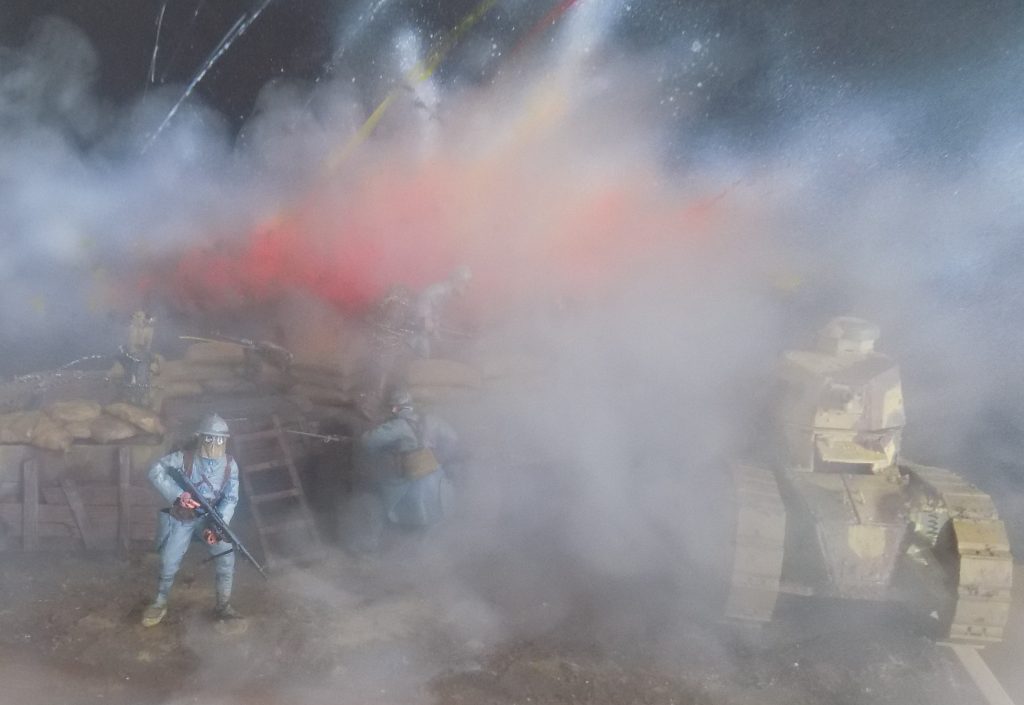
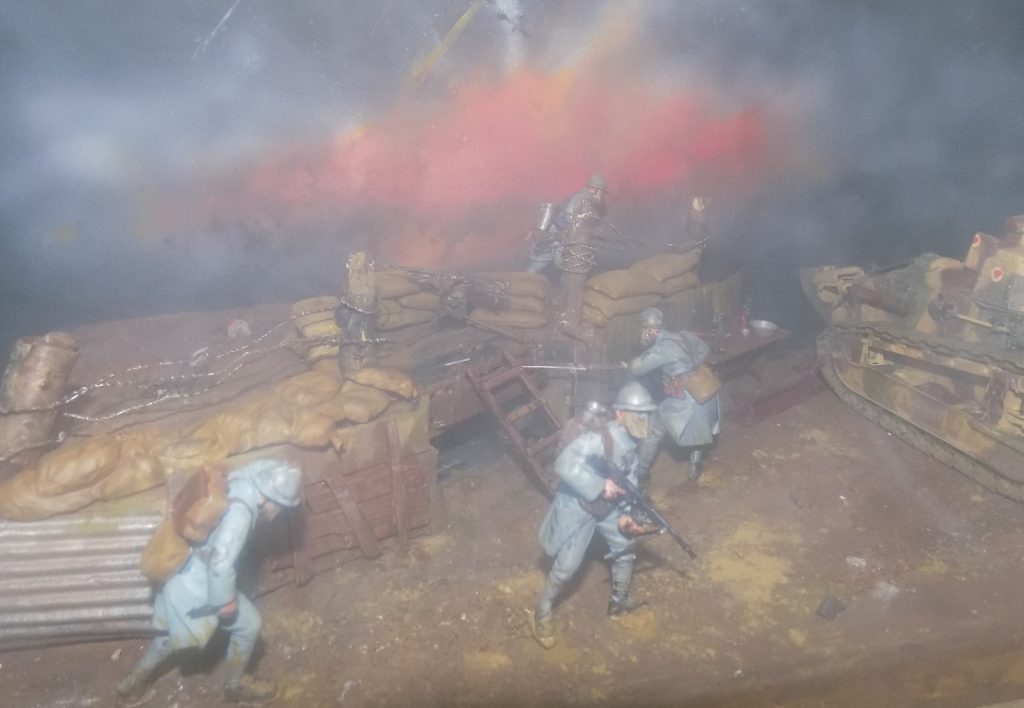

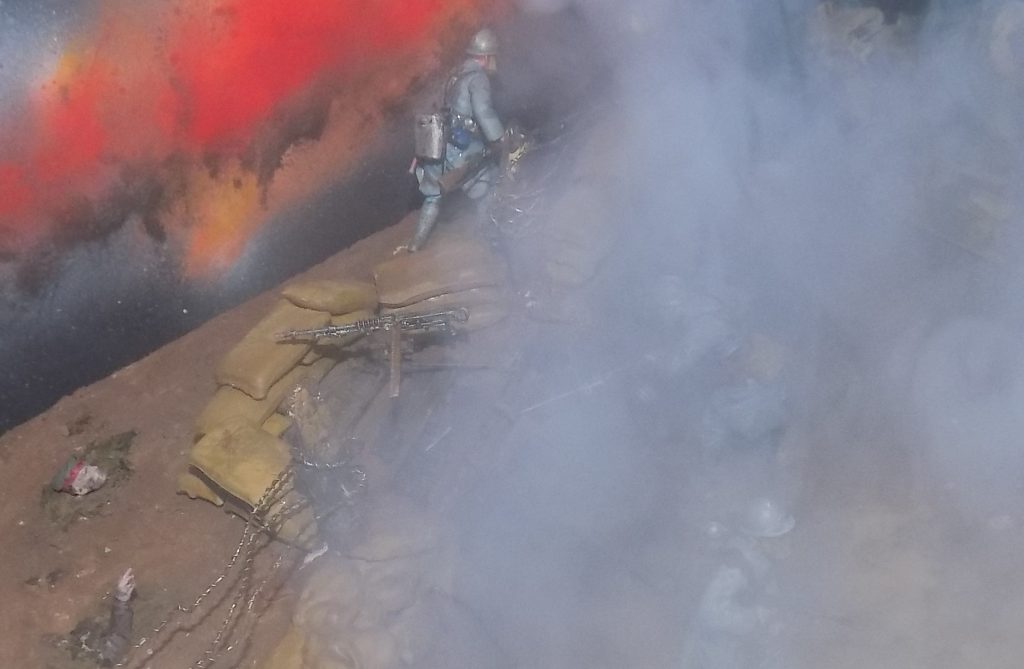
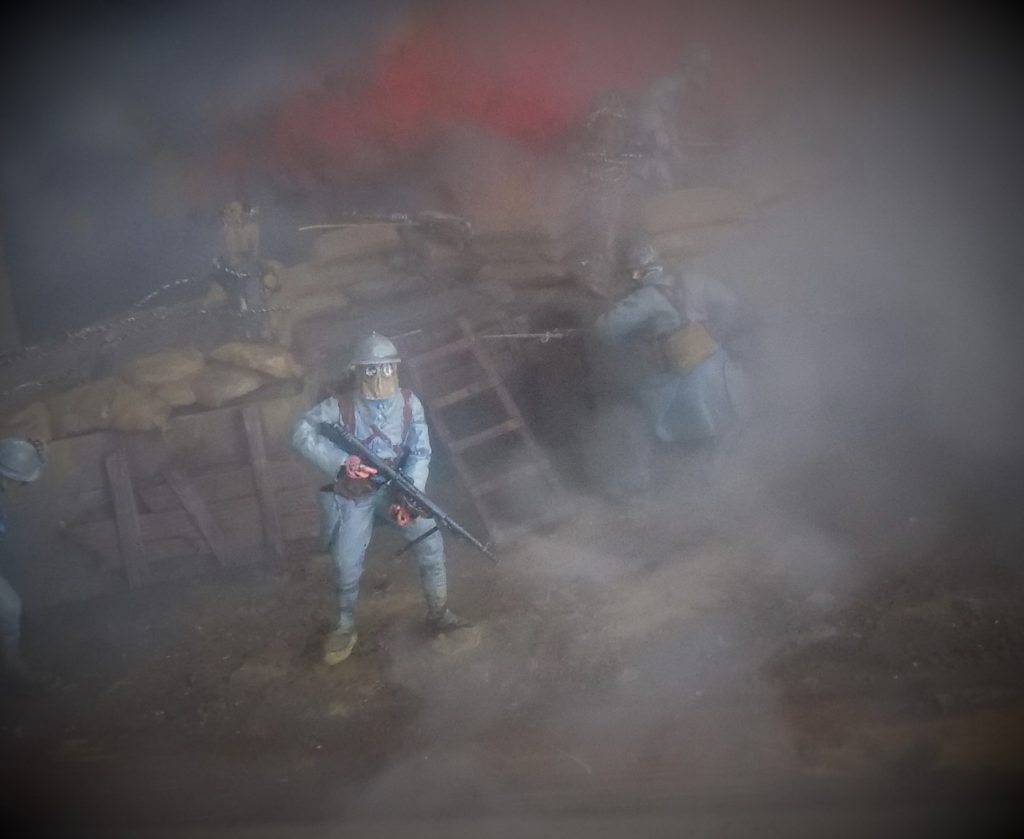

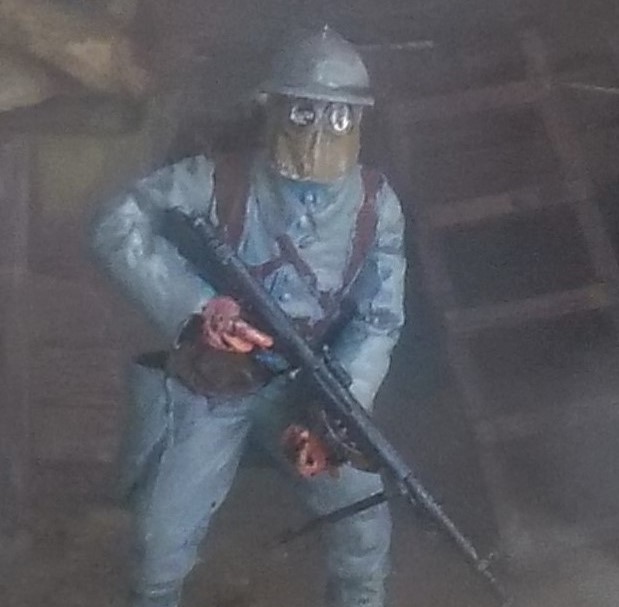
This project has been a multi-national collaboration:
Figures and accessories by ICM (Ukraine)
Renault FT-17 and Hotchkiss machine gun by Meng (China)
Barbed wire by Fog Models Uk
Furniture by Miniart (Ukraine)
Rats and decapitated head by Jon Smith Modellbau (Germany)
Sandbags by Tamiya and Meng
Smoke effects by Eileen of St Thomas, Exeter, UK!
Chemical warfare in the First World War
Chemical and biological weapons have a long record of usage. Poisonous fumes were reportedly used by the Spartans in the Peloponnesian war (429 BC). The Mongols threw the corpses of plague victims into the besieged city of Khaffa in Crimea in 1346 and blankets infected with small pox were given by the British to hostile Indian tribes in Ohio in 1763.
Gas had been considered as a weapon before the outbreak of war in 1914, but there was a general consensus that it was wholly ‘uncivilized’ or ‘unsportsmanlike’. The use of gas had been expressly forbidden by the Hague Convention of 1907. Yet all that changed with trench warfare and chemical science, industry and military technology all combined to facilitate the first large-scale and systematic use of chemical weaponry.
The Germans were the first to employ gas as a weapon in the FWW, at Neuve-Chapelle in October 1914, and next in January 1915 near Bolimov, Poland, on the eastern front against the Tsarist Army.
The amount of gas launched (in shrapnel shells) was small and hardly noticed by the French while the xyilil bromide (tear gas) used against the Russians froze in the low temperature and so did little damage.
Nevertheless, the Germans persevered and in April 1915, they released the lethal chlorine gas, which did have a significant effect. It kills by destroying the respiratory organs in a few seconds and causes fluid to be produced in the lungs in which the victim literally drowns.
It was used to devastating effect in the Second Battle of Ypres in April 1915.
During 1916 the combatants turned to the less lethal and odourless mustard gas, a blistering agent that could be fired by shell. It was a slow acting agent that causes internal and external bleeding and vomiting and frequently leads to death.
However, proponents of gas warfare concluded that lethality was neither necessary nor desirable. They reasoned that gas casualties who survived with considerable infirmity were a constant burden on enemy medical facilities and detrimental to enemy morale in the long run.
Gas was dispersed in two ways. It was released in vapour form by fixed canisters positioned in or near the front line, a technique that wholly relied on the wind blowing in the right direction and one that meant gas was effectively a short-range weapon. Artillery shells filled with an agent in liquid form that evaporated after a small explosive charge burst the shell open were widely used from 1916.
Gas was also put in HE rounds in small quantities for a ‘mixed’ effect. Artillery shells gave greater range and much better accuracy, but some problems remained.
Gas was not a truly effective weapon as it needed a long list of ideal conditions. It often failed dues to adverse weather, especially the strength and direction of the prevailing wind and the temperature. It was quite common for gas to be blown back into the attackers’ faces by contrary winds.
All sides quickly developed gas masks and these became more and more sophisticated. Early ones consisted of cotton pads soaked in bicarbonate of soda, to cover the mouth and nose, and separate goggles, but these gave way in all armies to the more familiar combined mask and respirator types. Filters were usually filled with charcoal or chemicals to neutralize the gas. Animals also needed protection from gas and the British Army began issuing horse respirators in 1916.
‘The Germans were the largest users (68,000 tons), then the French (36,000) and British (25,000). Although hundreds of thousands of soldiers were affected by gas during the war, those killed amounted to only about 3% of casualties. After-effects were, however, persistent, so that many veterans were troubled by breathing difficulties for the rest of their lives, had their lives shortened and were prone to common respiratory diseases. Gas aroused a peculiar horror among all combatants. It was not accidental that the first and universal measure of post-war arms control was the prohibition of the use of lethal gas, a ban which has remained generally effective since 1925’. (John Keegan, The First World War).
A personal account
During the second battle of Ypres on April 22 1915, the Germans used their secret weapon of chlorine gas:
‘The scene was more than sad; it was tragic. Everywhere were fugitives: Territorials, joyeux (‘happy ones’, French nickname for their African troops), tirailleurs, Zouaves, artillerymen-without weapons, haggard, greatcoats thrown away or wide open, running around like madmen, begging for water in loud cries, spitting blood, some even rolling on the ground making desperate efforts to breathe. I shall see for a long time, in particular, a staggering joyeux who with loud cries demanded water and noticing me, called, ‘ Colonel, those bastards have poisoned us!’ We soon gave that up. It was no longer soldiers who were escaping but poor souls who had suddenly become insane. All along the canal was the same scene: without noticing bullets or shells, a crowd of unfortunate sufferers on both banks had come to beg for water to relieve their horrible sufferings’.
Colonel Henri Mordacq, HQ, 45th Division. From ‘The Great War’. By Peter Hart.
Adolf Hitler
In mid-August 1918, the List regiment, in which Hitler served, was moved to Cambrai to help combat a British offensive. At the end of September the regiment was put under pressure from British assaults near Comines and it suffered badly. On the night of 13-14 October, Hitler himself fell victim to mustard gas and he and several comrades, retreating from their dug-out during a gas attack, were partially blinded and only found their way to safety by clinging to each other. For Hitler, the war was now over and it was in hospital at Pasewalk, recovering from his temporary blindness, that Hitler was to learn the shattering news of defeat and revolution, an experience that left him traumatised or hysterical, The gas attack and the damage to his lungs possibly accounts for his rasping and harsh voice.